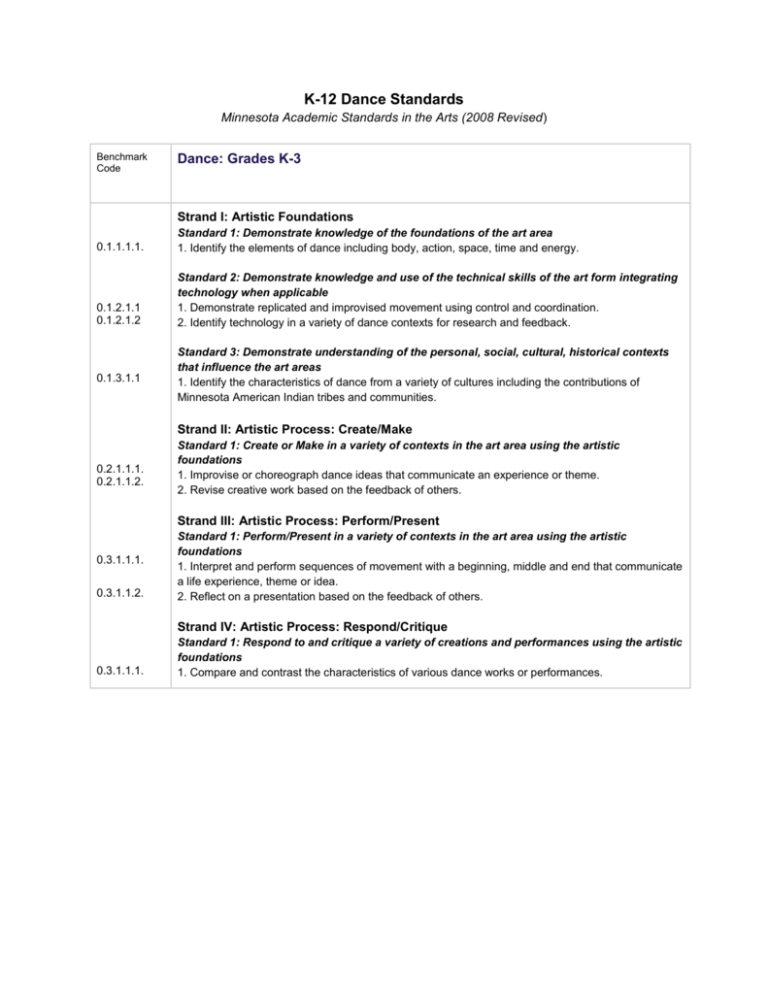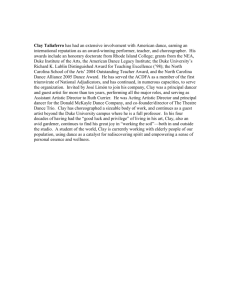K-12 Dance Standards Minnesota Academic Standards in the Arts
advertisement

K-12 Dance Standards Minnesota Academic Standards in the Arts (2008 Revised) Benchmark Code Dance: Grades K-3 Strand I: Artistic Foundations 0.1.1.1.1. Standard 1: Demonstrate knowledge of the foundations of the art area 1. Identify the elements of dance including body, action, space, time and energy. 0.1.2.1.1 0.1.2.1.2 Standard 2: Demonstrate knowledge and use of the technical skills of the art form integrating technology when applicable 1. Demonstrate replicated and improvised movement using control and coordination. 2. Identify technology in a variety of dance contexts for research and feedback. 0.1.3.1.1 Standard 3: Demonstrate understanding of the personal, social, cultural, historical contexts that influence the art areas 1. Identify the characteristics of dance from a variety of cultures including the contributions of Minnesota American Indian tribes and communities. Strand II: Artistic Process: Create/Make 0.2.1.1.1. 0.2.1.1.2. Standard 1: Create or Make in a variety of contexts in the art area using the artistic foundations 1. Improvise or choreograph dance ideas that communicate an experience or theme. 2. Revise creative work based on the feedback of others. Strand III: Artistic Process: Perform/Present 0.3.1.1.1. 0.3.1.1.2. Standard 1: Perform/Present in a variety of contexts in the art area using the artistic foundations 1. Interpret and perform sequences of movement with a beginning, middle and end that communicate a life experience, theme or idea. 2. Reflect on a presentation based on the feedback of others. Strand IV: Artistic Process: Respond/Critique 0.3.1.1.1. Standard 1: Respond to and critique a variety of creations and performances using the artistic foundations 1. Compare and contrast the characteristics of various dance works or performances. Benchmark Code 4.1.1.1.1. 4.1.1.1.2. 4.1.1.1.3. 4.1.2.1.1. 4.1.2.1.2. 4.1.3.1.1. 4.1.3.1.2. 4.2.1.1.1. 4.2.1.1.2. 4.3.1.1.1 4.3.1.1.2 Dance: Grades 4-5 Strand I: Artistic Foundations Standard 1: Demonstrate knowledge of the foundations of the art area 1. Describe the elements of dance including body, action, space, time and energy. 2. Describe how choreographic principles such as repetition, pattern or unity are used in the creation, performance or response to dance. 3. Identify Western and non-Western styles or genres of dance such as African, ballet, Capoeira, classical, Indian, folk, improvisation, modern, social tap/percussive and West African. Standard 2: Demonstrate knowledge and use of the technical skills of the art form integrating technology when applicable 1. Demonstrate movement using control, coordination and balance in movement replication and improvisation in more than one dance tradition. 2. Describe how technology is used in a variety of dance contexts for research and feedback. Standard 3: Demonstrate understanding of the personal, social, cultural, historical contexts that influence the art areas 1. Describe the cultural and historical traditions of dance including the contributions of Minnesota American Indian tribes and communities. 2. Describe how dance communicates meaning. Strand II: Artistic Process: Create/Make Standard 1: Create or Make in a variety of contexts in the art area using the artistic foundations 1. Create movement sequences and improvisations using choreographic forms to express an idea, theme, image or tradition. 2. Revise creative work based on the feedback of others and self-reflection. Strand III: Artistic Process: Perform/Present Standard 1: Perform/Present in a variety of contexts in the art area using the artistic foundations 1. Interpret and perform movement characteristics and styles of more than one dance form or tradition. 2. Revise a performance based on the feedback of others and self-reflection. Strand IV: Artistic Process: Respond/Critique Standard 1: Respond to and critique a variety of creations and performances using the artistic foundations 1. Justify personal interpretations and reactions to various dance works and performances. 4.4.1.1.1 Benchmark Code Dance: Grades 6-8 Strand I: Artistic Foundations 6.1.1.1.1. 6.1.1.1.2 . 6.1.1.1.3. 6.1.2.1.1. 6.1.2.1.2. 6.1.3.1.1. 6.1.3.1.2. 6.2.1.1.1 . 6.2.1.1.2. 6.2.1.1.3. Standard 1: Demonstrate knowledge of the foundations of the art area 1. Analyze the elements of dance including body, action, space, time and energy. 2. Analyze how choreographic principles, such as repetition, pattern, unity, theme and variation, are used in the creation, performance or response to dance. 3. Describe Western and non-Western styles or genres of dance, such as African, ballet, Capoeira, classical, Indian, folk, improvisation, modern, social tap/percussive and West African. Standard 2: Demonstrate knowledge and use of the technical skills of the art form integrating technology when applicable 1. Integrate control, coordination, balance, body alignment and musicality through movement replication and improvisation in more than one dance tradition. 2. Select technology for purposes of research, documentation and feedback. Standard 3: Demonstrate understanding of the personal, social, cultural, historical contexts that influence the art areas 1. Compare and contrast the connections among works in dance, their purposes and their cultural, historical and social contexts, including the contributions of Minnesota American Indian tribes and communities. 2. Analyze the meanings and functions of dance, such as dance as art and dance as entertainment. Strand II: Artistic Process: Create/Make Standard 1: Create or Make in a variety of contexts in the art area using the artistic foundations 1. Create movement motifs, phrases, improvisations and dances that demonstrate choreographic form in a variety of dance contexts. 2. Revise creative work based on the feedback of others, self-reflection and artistic intent. 3. Develop an artistic statement, including how audience and occasion influence creative choices. Strand III: Artistic Process: Perform/Present 6.3.1.1.1. 6.3.1.1.2. 6.3.1.1.3. Standard 1: Perform/Present in a variety of contexts in the art area using the artistic foundations 1. Rehearse and perform dance in a variety of contexts including solos and ensembles. 2. Revise a performance based on the feedback of others, self-reflection and artistic intent. 3. Develop an artistic intent, including how audience and occasion impact performance choices. Strand IV: Artistic Process: Respond/Critique 6.4.1.1.1. Standard 1: Respond to and critique a variety of creations and performances using the artistic foundations 1. Analyze and interpret a variety of dance works and performances using established criteria. Benchmark Code Dance: Grades 9-12 Strand I: Artistic Foundations 9.1.1.1.1. 9.1.1.1.2. 9.1.1.1.3. 9.1.1.1.4. 9.1.2.1.1. 9.1.2.1.2 9.1.3.1.1 . 9.1.3.1.2, Standard 1: Demonstrate knowledge of the foundations of the art area 1. Analyze how the elements of dance including body, action, space, time and energy are combined to communicate meaning in the creation of, performance of, or response to dance. 2. Analyze how choreographic principles such as repetition, pattern, unity, theme and variation are used in the creation of, performance of, or response to dance. 3. Analyze how Western and non-Western styles or genres of dance such as African, ballet, Capoeira, classical, Indian, folk, improvisation, modern, social tap/percussive and West African, contribute to the creation of, performance of, or response to dance. 4. Apply understanding of the health and safety issues related to dance. Standard 2: Demonstrate knowledge and use of the technical skills of the art form integrating technology when applicable 1. Synthesize control, coordination, balance, body alignment, musicality and expressive qualities through movement replication and improvisation in more than one dance tradition. 2. Select technology for purposes of research, feedback, documentation, choreography and production. Standard 3: Demonstrate understanding of the personal, social, cultural, historical contexts that influence the art areas 1. Analyze how a work in dance influences or is influenced by the personal, social, cultural and historical contexts, including the contributions of Minnesota American Indian tribes and communities. 2. Synthesize and express an individual view of the meanings and functions of dance such as dance as art, ritual, cultural expressions, entertainment, spectacle and its social contexts. Strand II: Artistic Process: Create/Make 9.2.1.1.1. 9.2.1.1.2. 9.2.1.1.3. Standard 1: Create or Make in a variety of contexts in the art area using the artistic foundations 1. Create solo or ensemble work that integrates technology and production elements in more than one context. 2. Revise creative work based on artistic intent and using multiple sources of critique and feedback. 3. Justify an artistic statement, including how audience and occasion influence creative choices. Strand III: Artistic Process: Perform/Present 9.3.1.1.1 . 9.3.1.1.2. 9.3.1.1.3. Standard 1: Perform/Present in a variety of contexts in the art area using the artistic foundations 1. Rehearse and perform solo and ensemble work that demonstrates technical, artistic and performance skills such as alignment, spatial use, musicality, dynamic range and expressivity. 2. Revise a performance based on artistic intent and using multiple sources of critique and feedback. 3. Justify artistic intent, including how audience and occasion influence performance choices. Strand IV: Artistic Process: Respond/Critique 9.4.1.1.1. 9.4.1.1.2. Standard 1: Respond to and critique a variety of creations and performances using the artistic foundations 1. Analyze, interpret and evaluate dance works and performances using self-selected criteria within the traditions of the art form. 2. Justify choices of self-selected criteria based on knowledge of how criteria affects criticism.




